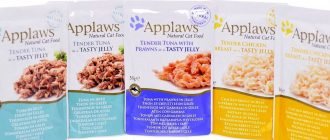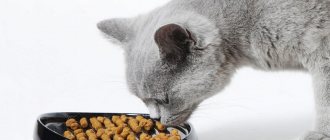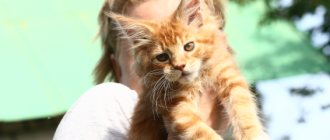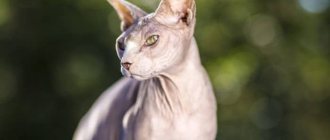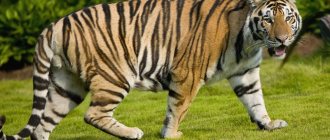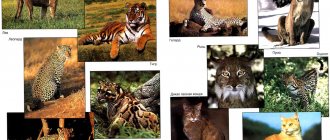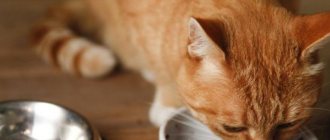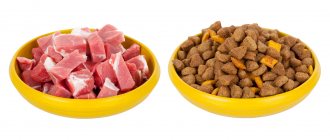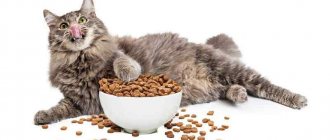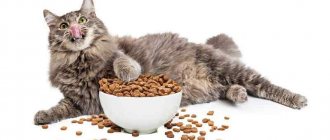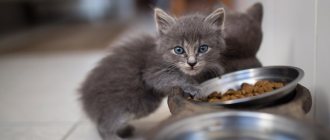Update date: 03/10/2021 10:29:57 9278 Share:
Author of the article: Astafieva Ekaterina Alekseevna
*Review of the best according to the editors of simplerule.ru. About the selection criteria. This material is subjective in nature, does not constitute advertising and does not serve as a purchase guide. Before purchasing, consultation with a specialist is required.
Sphynxes are a hairless breed whose representatives need to exercise more to stay warm. These cats eat a lot to replenish used energy. Pets are not too picky about food, so pet owners need to constantly monitor the diet of their four-legged friend.
We have prepared a rating of the best food for Sphynx cats, which are popular among buyers. The list was compiled taking into account important parameters and expert opinions.
Dietary features of sphinxes
In Sphynxes (Canadian, Donskoy, Peterbald), like other hairless cats, due to the lack of fur, energy exchange processes occur at a high speed in order to maintain body temperature. Therefore, they need increased nutrition. At the same time, any cat will envy the appetite of sphinxes. They are not picky, they eat everything and can even eat inedible things as a “supplement”. It is difficult for them to resist a piece of chocolate or grapes; they will happily eat what is left on the plate after the owner’s dinner. In reviews, owners say that Sphynx cats like foods that ordinary cats won’t eat.
However, if other breeds begin to eat from the master's table and this does not affect their well-being, then the Canadian Sphynx will suffer from diarrhea. This also applies to changing your diet. If for other cats it takes a week to switch to a new food, for sphinxes it takes at least a month.
Improper nutrition is the cause of dysbiosis. The problem is common among Sphynxes and is easier to prevent. Many breeders believe that high-quality dry cat food is better for health and guarantees a long life.
Essential vitamins
The Sphynx cat should be fed food containing a set of all necessary vitamins.
- Meat products, especially liver, contain vitamin A.
- To maintain all body functions of cats, food must contain large amounts of B vitamins, which are found in cereals.
- Greens are the main source of vitamin C.
- Sphynx cats love to lie in the sun, producing vitamin D on their own. This vitamin is also found in fish, milk, butter and is responsible for strong bones. Calcium is also needed for the same.
- Chicken eggs, vegetable oil, and offal contain vitamin E, which promotes the proper functioning of reproductive function, the muscular system, the breakdown of fat and prevents the spread of infection.
Cats need vitamins to live a healthy, long, and happy life.
What food to choose for your Sphynx
Food for Sphynxes should only be premium, super premium and holistic.
Premium dry food:
- Acana;
- Bosh.
Super premium food:
- Orijen;
- AATU;
- Eagle Pack;
- Hill's;
- Eukanuba;
- Iams;
- Nutro;
- Advance;
- Royal Canine.
Holistic class:
- Azmira;
- Canidae;
- Eagle Pack;
- Felidae
Almost all brands produce dry food specifically for elderly, pregnant cats, castrates, kittens, animals leading a sedentary lifestyle, and medicinal ones. Wet food is also divided into classes; it can be medicinal and dietary. If an animal has a food allergy, there are special hypoallergenic foods, both dry and wet.
For example, Royal Canine produces specially dry food for sphinxes. However, reviews about the line are contradictory. It's all in the composition. The main share is occupied by dehydrated proteins of animal origin (poultry). It is impossible to determine exactly what part of the bird was used in production. The remaining ingredients are also named in general terms and it is impossible to understand exactly what they are obtained from. It contains unwanted grains - wheat and cereal flour.
Food from different manufacturers is not mixed, only one is fed. Each manufacturer has its own ingredients and dosage. If you mix, then we are no longer talking about balance. And if there is a need to change the brand, then the transition to a new food is carried out gradually.
A cat should always have plenty of water when feeding dry food. The animal needs to drink 2-3 times more water than it eats granules. If the sphinx turns out to be a “light drinker,” then the owner will either have to reconsider the diet and switch to natural food / wet canned food (which is expensive) or supplement the pet with a syringe. Some cats begin to drink more when they are given a drinking fountain instead of a regular water bowl.
Lack of water during dry feeding is a serious burden on the kidneys. The risk of urolithiasis and constipation increases, the consequence of which is intestinal damage.
It is strictly forbidden to feed Sphynxes with economy-class food, which is widely available on the shelves of regular stores. The fact is that the main source of protein in such products is plants: soybeans, corn, wheat. But vegetable protein is not absorbed by the cat’s body. The meat component is minimal; as a rule, it is offal, poultry feathers, and fat.
The lower the class of food, the more dyes, preservatives, and flavor enhancers it contains.
What to look for when choosing food
When deciding what to feed your Sphynx, the first thing you need to do is consult with a breeder and a veterinarian, preferably specializing in this breed. But the latter is rare. Secondly, carefully study the composition.
Nutrition for illnesses
Sphynx cats require a healthier and more balanced diet than other cat breeds - they have a very sensitive digestive system. The slightest violation in the diet - diarrhea cannot be avoided.
The main condition for choice is control of protein levels and the absence of ingredients in the food that can cause stool upset. If problems with the gastrointestinal tract do arise, replace the food with a special one, after consulting with a veterinarian.
Rating of veterinary food:
- GO Sensitivity Shine;
- 1st Choice;
- Gina Elite Cat Sensitive;
- Josera SensiCat;
- Bozita Feline Funktion Sensitive Diet & Stomach;
- Hill's Science Plan Sensitive Stomach;
- Royal Canin Sensible 33.
Important to know: What to feed a spayed or neutered Sphynx.
Natural nutrition in the diet
A number of breeders and owners of hairless cats believe that the diet of Sphynx cats should be only natural.
For each specific pet, the diet is compiled individually and often experimentally.
Diet example:
- The basis is meat. Preference is given to raw beef, poultry (chicken, turkey), rabbit, and lamb. The meat is given without bones. It is first scalded or frozen (6-10 days). If you are allergic to raw beef or chicken, which happens with sphinxes, the meat is boiled. Meat products should account for 60% of the diet. And if the kitten is given 30 grams. meat per day, then for an adult cat up to 360 gr.
- Offal – boiled beef liver (no more than 2 times a week), heart, chicken gizzards.
- Chicken necks and heads - pre-beaten.
- Dairy products - cottage cheese, fermented baked milk, kefir, yogurt without additives. You can use hard cheese.
- Eggs are a healthy product. Give 2 times a week. Quail - a whole egg, if chicken - the yolk is better, raw or boiled.
- Fish is given to the Don Sphynxes and no more than once every 2 weeks. Only sea food, boiled, without bones. If urolithiasis or other health problems are suspected, it is completely excluded from the menu. Canadian Sphynxes have weaker digestion and it is advisable to remove fish from their menu.
- The following grains are allowed: rice, buckwheat. They are given in the form of porridge.
- Grated vegetables: zucchini, pumpkin, carrots, cabbage. Other vegetables and fruits that are low in starch are suitable, except tomatoes and grapes. Usually vegetables are grated and mixed with meat and porridge.
- Grass - germinate oats, wheat or purchased mixtures.
All food is served “on the table” of the Sphinx at room temperature. Never from the refrigerator or hot. It is recommended to bake or boil cereals and vegetables, this way they are better absorbed. In addition, vegetable oil (1 tsp) is added to them as a source of fatty acids.
What food should not be given
Sphinxes should not be given any food from the owner's table.
The following types of products are prohibited:
- Tubular bones - there is a high risk that the cat will choke or injure its stomach.
- Pork is a fatty meat and is poorly digestible by sphinxes. Raw duck and goose meat leads to infection with worms.
- Fried, fatty foods provoke intestinal disorders, which negatively affects the appearance of the animal.
- Sweets and baked goods cause allergies and metabolic disorders. The glands produce secretions more actively, and the skin becomes more dirty. Chocolate is a poison for any cat, causing poisoning.
- Potatoes, beans, soybeans are not digested in the intestines. They cause flatulence and are useless for the animal.
- Garlic and onions in any form have a detrimental effect on the blood, causing anemia.
- Spices, including salt, are of no benefit to the cat.
- Milk is prohibited for animals older than 3 months. A common cause of prolonged diarrhea.
Pros and cons of different types of nutrition
Heated debates between veterinarians and owners continue over what to feed Sphynx cats. Both natural and industrial nutrition have their advantages and disadvantages.
Rules for feeding kittens
Babies are sold in nurseries at 2-3 months, when they can already feed themselves.
Babies are sold in nurseries at 2-3 months, when they can already feed themselves. Breeders create an initial diet for kittens, but it is not necessary to adhere to it in the future.
In clubs, cats are fed commercially prepared products; owners often switch their pets to natural feeding. In order not to spoil the functioning of the gastrointestinal tract, a smooth transition is organized by feeding the animal with new components of the diet.
Attention! It is forbidden to mix dry and homemade food. Food varies in density and requires the production of different enzymes, which disrupts digestion and metabolism.
Up to 3 months, food is given 6-7 times, 25 g each. As the cat grows older (by the age of one year), the cat is transferred to two meals a day, 50 g per serving. High-quality food has a product line according to age and disease.
Correct menu by month
The list of prohibited and permitted products is individual for each age.
At all stages, a kitten needs microelements that contribute to the development and strengthening of muscle and bone tissue, and the formation of the body.
| Month | Menu for the day |
| 1-3 |
|
| 4-5 |
|
| 6-8 |
|
| 9 and older |
|
Be sure to read:
Development of kittens by weeks and months: how they grow, look, until what age is considered a kitten
Homemade food or ready-made food
There is a myth that natural food is healthier than prepared food. But that's not true. New ready-made foods contain more nutrients needed by a breed or individual with a specific disease or stage of physical development.
Dry food is convenient, it does not need to be heated or cooked, and it is easier to calculate portion sizes. But high-quality products are expensive, so purchasing dry granules weekly becomes problematic. Economy options have a bad effect on the animal’s genitourinary system and gastrointestinal tract.
Natural nutrition requires searching for products, proper preparation, and storage . In addition, such feeding requires the use of supplements.
The advantage is careful selection of the composition. Only the owner decides what to include in the pet's diet.
How many times a day should you feed a kitten?
Natural nutrition requires searching for products, proper preparation, and storage.
From childhood, pets are taught to follow a meal schedule. This makes caring for the animal easier and promotes healthy eating behavior.
For each age, a certain feeding frequency is prescribed.
| Age (months) | Regularity (once a day) |
| 1-3 | 5-6 |
| 4 | 5 |
| 5-6 | 4 |
| 8-9 | 3 |
| 10 and older | 2 |
How much food and water to give at a time
To prevent the kitten from becoming thirsty, a drinking bowl with clean boiled water should be available. In summer, the volume of drinking increases and the amount of food is reduced. Each cat's nutritional needs are unique.
This depends on the pet’s activity, its physical and moral condition, possible health or weight problems. On average, up to a year, a baby needs 100-120 g of food. This amount is divided equally among all techniques.
An adult Sphynx will need at least 200-250 g of protein base and 100 g of carbohydrates.
The dry food indicator is indicated on the pack of a specific brand. Experts believe that it is better to reduce the volume of finished products to 300-400 g per day, that is, give 150-200 g in the morning and evening. If there is food left in the bowl, it is removed until next time, and the portion is reduced.
Be sure to read:
When to start feeding kittens: how to introduce them, diet, what not to feed, age for first feeding
Vitamins and supplements in the Sphynx diet
If dry food is chosen as the Sphynx's diet, then vitamins and supplements are not used. Hypervitaminosis is no less dangerous than a lack of vitamins.
With a natural diet, it is important to choose the right vitamins for sphinxes. The veterinarian will help with this. Apply:
- brewer's yeast is a source of B vitamins, the dosage of which is calculated based on the weight of the animal;
- mineral supplements such as Kizim, Jim Pet, Sanal, Brevers 8 in 1, Canina.
Some owners and breeders are of the opinion that if the natural menu is precisely adjusted, the pet is healthy - no vitamins are needed.
Food for a neutered cat
If the animal is sterilized, then it is necessary to purchase special food for it.
The Sphynx's diet depends on the individual characteristics of the cat, its gastronomic preferences, weight, age and activity. For sterilized and neutered individuals, you should purchase special food to avoid the development of complications and urolithiasis. Suitable hypoallergenic premium, super-premium or holistic food. The selected product should prevent the development of obesity.
Changing your diet
The Sphynx's digestive system reacts sharply to changes in diet, especially at a young age.
When a kitten is taken home, at first it needs to be fed in the same way as in the nursery. If for some reason there is no information about this, then the most optimal is veal (raw or boiled), cottage cheese, finely chopped yolk, meat and vegetable pate. Gradually introduce rice and buckwheat porridge. It is better to get used to cereal dishes from childhood. An older cat will refuse porridge.
When choosing what to feed sphinxes, you should give preference to either dry food or natural food. Mixing two types of food is prohibited. If a decision is made on a mixed diet, then drying is given in the morning, natural in the evening, or vice versa. Different types of food are digested by different enzymes, and the intestines need time to rebuild.
When feeding dry feed, the dose is calculated depending on the recommendations of the feed manufacturer. With natural nutrition, depending on the animal’s weight and health status. On average, for kittens the daily feeding rate is 10% of body weight, for adult animals - 5% of body weight.
Basic needs of the breed
A distinctive feature of Sphynxes is their lack of fur. Therefore, this breed is considered hypoallergenic. But due to the fact that they do not have fur, cats require much more energy to maintain immunity and health. For this reason, representatives of this species have an accelerated metabolism, a good appetite and are able to eat anything they find. Because of this, the formation of a diet for such pets must be approached responsibly so that the animal receives its daily intake of all necessary nutrients.
It is important to monitor what such a cat eats, since Sphynx cats are indiscriminate eaters. The use of low-quality food with a high content of flavor enhancers can cause intestinal upset in Sphynx cats with their high metabolism.
When feeding such pets, you must adhere to the following rules:
- each food distribution is given to the sphinx in a strictly dosed portion (food or natural food);
- compliance with the regime. This is convenient for both the owner and very useful for proper digestion of the animal;
- taking into account the pet's age. Kittens, adult cats, pregnant cats and older animals should stick to their diet.
Is the diet suitable for the Sphynx?
In hairless cats, thinness and excess weight are equally noticeable. Therefore, it is quite easy to visually assess whether the food is suitable for pets.
There are several other signs:
- The stool is formed, not dry and not too soft. The cat goes to the toilet very regularly.
- The skin is clean, no acne. Discharge is normal - this means that the sphinx needs to be bathed once every 2 weeks, and for some representatives of the breed even less often.
- The ears don't leak. Excessive discharge from the ears occurs in the Canadian Sphynx due to poor diet.
- The pet is well-fed, but without folds of fat.
- The ribs do not protrude, but can be felt well with fingers.
- The mood is playful and cheerful.
Therefore, if the animal is healthy and feels good, then the diet is correct and there is no need to change it. Cats don't need variety.
Sample menu by age
By creating a sample menu by age, you can calculate your capabilities...both physical and financial. If you decide to become the owner of a hairless cat, it is better to immediately expect that your pet will have to be switched to a hypoallergenic diet. In this matter, it is better to “overprepare” than to face the unexpected.
A cat's skin is an indicator of its health. In cats with long hair, the deterioration of the skin condition may not be noticeable for some time; in hairless pets, all symptoms are noticeable immediately. One of the signs of malnutrition is a plaque on the skin that leaves marks on which the cat sat or slept.
What to feed a pregnant cat
During pregnancy, a Sphynx cat's appetite increases. The need for food increases by 2 times. Portions are reduced, but the number of feedings is increased to 3-4 per day. There is also a requirement for the diet - it must be balanced.
Pregnant women sometimes require mineral supplements. It is important to ensure that they do not contain an additive such as biotin. The component promotes hair growth, which is not adornment for hairless cats.
Problems with improper feeding
The criterion “does my cat like it” should not determine the choice of food for feeding the Sphynx, who is ready to eat anything without thinking about the consequences. And they can be very unpleasant:
- systemic digestive disorders;
- chronic diseases of internal organs;
- metabolic disorders;
- allergies and various dermatological diseases.
A Sphinx who eats at the same table with you should not cause tenderness, but anxiety
Overeating is detrimental for any cat, and for the Sphynx, whose sense of fullness is muted, it is especially dangerous. Hairless cats very easily experience metabolic failures, and metabolic disorders lead to obesity, which is fraught with quite serious problems - from acne to functional disorders of all body systems.
What to feed a Sphynx kitten
When thinking through a kitten’s diet, it is important not to overfeed.
From 3 weeks, kittens are gradually accustomed to new food. This is also done by the breeder. Upon purchase, he will tell you how to feed the kitten correctly. The basis of the diet is still mother's milk, but a little meat and a cat's milk substitute are introduced as complementary foods.
The most active growth occurs at the age of 5-8 weeks. They begin to feed the kittens wet food or expand the diet: vegetables + meat.
From 3-4 months the process of changing teeth begins. During this period, it is very important that the diet is balanced and contains vitamins and microelements. Dry food is introduced little by little. The granules are soaked and mixed into the scraped meat. However, it is better not to give drying until 6 months, while the intestinal microflora is forming.
An approximate menu by age is presented in the table:
| Kitten age | Daily food intake | Number of feedings | Permitted industrial feed | Natural products |
| From 3 weeks to 1 month | Based on appetite | For artificial kittens – 8 times a day, including at night. | Cat milk replacer (Royal Canin, Beafar brands). If the stool is loose, it is better to dilute the milk with a little water. | Frozen beef; baby food with meat (in jars); low-fat cottage cheese. |
| 1.5 - 2 months | 120-150 gr. | 6 times | Cat milk replacer (Royal Canin, Beafar brands) Canned food for kittens Akana, Orijen | Beef (frozen); quail egg; vegetables. |
| 3-6 months | 180-240 g | 4 times | Canned food and you can introduce dry food Akana, Orijen | Beef (40-45 gr.); offal (heart, liver); quail egg; chopped chicken necks, heads; vegetables. |
From 9 months, kittens are transferred to 3 meals a day. At one year, the kitten eats like an adult animal - 2 times a day.
Are additional beneficial supplements required?
By feeding the Sphynx with high-quality complete food, the owner does not have to worry about any additional feeding - the animal gets everything it needs without it. For cats that eat natural food, vitamin and mineral supplements are required - their composition and dosage should be recommended by a veterinarian, taking into account the characteristics of a particular animal and its diet.
Sphynxes are not only famous gluttons, but also sophisticated gourmets. Many of these breeds of cats love leafy greens, which are rich in vitamins and minerals. You should not deny your pet this healthy treat, even if you think that his diet is completely balanced and full of everything he needs.
Many bald cats generally have a weakness for fresh greenery - even for ordinary lawn grass, which is usually recommended for breeds with long and thick hair, in order to clear the cat’s stomach of its stray clumps. But don’t forget that your Sphynx could also use this cleansing and vitamin natural supplement.
Let him nibble the grass rather than eat your indoor plants - especially since among them there may be specimens that are dangerous to the cat.
Video: unusual gastronomic preferences of the Sphinx
Sphynx care
Maintaining hygiene and caring for the Sphynx requires great attention; they do not have a protective coat, and their eyelids do not have eyelashes.
- Monitor the condition of the skin and keep it clean. Constant sweating, many sebaceous glands secreting fatty secretions cover the body with a dirty film and smell bad. To keep the skin clean and healthy, your pet is often bathed and wiped with wet wipes.
- Dust and dirt accumulate in the large form of the ears, which leads to dark waxy discharge. Care and maintenance of the Sphynx ears consists of removing mucus using swabs and cotton swabs.
- In the evening, discharge accumulates on the mucous membrane of the eyes, unprotected by eyelashes; they are transparent, similar to tears, and must be regularly removed with wet wipes. Dark, purulent accumulations in the corners indicate infection. In this case, immediately seek advice from a veterinarian.
Skin care
The skin of hairless cats resembles human skin and requires constant care for sphinxes, which includes the following hygiene procedures:
- Bathing, more often 2-3 times a month.
- Wiping with a damp cloth or napkins.
- Moisturizing will help regular baby cream to peel off and even peel off.
Washing and bathing
Hairless cats often sweat, so you need to know how to wash your Sphynx. The opinion about daily bathing is not entirely true. How often to bathe the Sphynx will be determined by the condition of the skin and the degree of its obesity.
You can navigate by the following signs:
- unpleasant pungent odor;
- unpleasant stickiness of the skin;
- fatty grayish dirty coating;
- accumulation of dirt in the folds of the skin;
All these signals will answer the question of how often to bathe the Sphynx, that it is time to bring the pet’s skin back to normal, to give the skin a clean suede look that is pleasant to the touch.
How to bathe a Sphynx kitten and when, many breeders recommend starting no earlier than 3-4 months of age. For kids, there is a risk of catching a cold and getting stressed from water procedures. While they live with their mother cat, she takes good care of hygiene and constantly licks them until they shine.
You should not frequently bathe a bald pet for more than 2-6 weeks, regardless of the degree of skin contamination, for the following reasons:
- Sphynxes are warm-blooded creatures and have a high body temperature, and after swimming they become hypothermic.
- Even specially selected shampoos and water damage the function of the sebaceous glands, which protects against external irritations and infections.
If absolutely necessary, if a hairless cat has soiled part of its body, it is wiped with a damp sanitary napkin with a neutral composition and odor, as for small children.
Before starting a bath, you need to prepare bath accessories and the sphinx itself, especially before the first bath in its life.
For swimming you will need:
- a large basin, in the bathroom for many it is inconvenient to wash a nimble, soapy pet;
- container with water for rinsing, the water temperature remains within 37-39 degrees.
- acquire a soft, delicate sponge, as for bathing a child;
- sanitary napkins will be needed to wipe the face;
- prepare 2-3 towels for wiping a wet pet dry;
- When swimming, all doors, windows, and vents are closed to prevent drafts.
The procedure for bathing a prepared sphinx consists of the following manipulations:
- cover the bottom of the basin with a towel or silicone mat;
- water is poured into the basin only until the paws are covered;
- calmly place the pet in the basin, gently stroke it;
- after the cat gets used to the water, apply shampoo to the sponge and massage the body;
- carefully remove the shampoo with prepared water until the soap is completely washed off;
- The body is wiped with a towel, and the face, eyes, and ears with a napkin.
When bathing the Sphinx, follow the following recommendations:
- the cat is not fed before bathing; it will tolerate the procedure easier on an empty stomach;
- in order not to scare the cat, it is useful to foam the water before bathing;
- You can wash your cat only 2 weeks after vaccination.
- you cannot bathe the sphinx in a cold room with a temperature below + 28-30 degrees;
- It is difficult and impractical to wash two animals at the same time;
- It is forbidden to bathe a pet if it is unwell.
Shampoo
Special shampoos for bathing and body care are available for sale for Sphynx cats.
Important! It is not allowed to wash the Sphynx with shampoos intended for other breeds of cats or for humans. They have compounds that are not suitable for the skin of hairless cats, which clog pores and cause irritation.
- “Ms.” is recommended especially for sphinxes. Kiss Graceful Sphinx contains biotin, which not only nourishes the skin, but also relieves irritation and itching.
- Shampoo-conditioner “Doctor VIC for hairless cats (Sphynx)” moisturizes the skin, relieves inflammatory irritation and itching. Enriched with keratin and provitamin B5.
- Foam shampoo “Le Artis for hairless cat breeds” . developed taking into account the characteristics of the skin with components that carefully cleanse and moisturize the skin.
Recommendations for using shampoos:
- shampoo is suitable for water with any hardness;
- the animal is well moistened with warm water, within 37-39 degrees;
- a little shampoo is dripped onto a sponge and distributed over the body with massage movements, forming soap foam;
- Allow the skin to loosen for a few minutes and rinse thoroughly with warm water;
- Wipe your body and ears dry with a towel.
Ear cleaning
Dust and dirt accumulate in the large ears of the sphinx, and sulfur is produced in the shells.
It is necessary to wipe the ears once a week with a special solution to remove accumulated discharge with a cotton swab.
Claws (nail trimming)
A special scratching post and a sharpener for the pet’s claws are installed in the house for the sphinx, but this is not enough; the pet’s claws must be trimmed. Naturally active hairless cats can be injured by overgrown claws and damage their delicate bare skin, which can lead to infections and skin diseases.
Nutrition for an adult cat
The easiest option for the owner is to choose industrial feed. This can be wet canned food or coarse dry granules.
The first option is healthier for the cat’s stomach, but wet pieces are stored open for several hours. In addition, they are produced in the form of single portions, which is not economically profitable.
The easiest option for the owner is to choose industrial feed
It is permissible to combine canned food and granules from the same manufacturer. This power option is convenient to use, transport, and store.
Economy options are not suitable for Sphinxes.
If the owner decides to feed his pet with a finished product, he will have to choose expensive super-premium food for hairless cats. The composition should not contain wheat, corn, preservatives, dyes, salts, or flavors. Protein content - at least 30%.
Natural diet includes:
- Meat (rabbit, turkey, lean lamb, beef).
- Eggs (2 yolks per week).
- Cottage cheese, kefir.
- Sea fish without bones (no more than 2 times every 7-10 days).
- Rice, buckwheat, oatmeal (without salt and water).
- By-products (except liver).
- Flaxseed or olive oil (2 teaspoons per day).
- Fresh and boiled vegetables, herbs (carrots, potatoes, beets, zucchini, fresh herbs).
Cats do not need variety for full development; 2-3 types of protein food are enough. Treats include treats from a pet store or low-fat soft cheese.
Important! When feeding at home, you need bait - sources of vitamins.
Health and diseases
Experts do not classify the Sphynx breed as an animal with poor health. The immunity of born kittens is normal; the Sphynx rarely coughs, but like the entire cat family, they can be susceptible to viral and bacterial infections.
The peculiarities of the breed are caused by the fact that Sphynxes were bred by breeders artificially through inbreeding in order to achieve a unique mutation with smooth, rubber-like, hairless skin with many folds. As a result, a unique breed was developed, but prone to genetic abnormalities that lead to sphinx disease and abnormalities in the development of organs: eyes, skin, mouth and spine.
The main diseases of sphinxes and pathologies:
- skin diseases, fatty sweating caused by bare skin, almost without hair;
- eye diseases and eye abnormalities, the cause is the absence of eyelashes;
- shortened lower jaw in the oral cavity or “carp bite”;
- underdevelopment of the thoracic and lumbar vertebrae, a common congenital disease;
- reduced growth as a consequence of serious defects.
My eyes are watering
Newborn kittens are predisposed to eye diseases caused by inflammatory processes of the cornea, causing conjunctivitis and scleritis. Eyes that are not protected by eyelashes, and sphinxes simply do not have them, are injured, and debris, dust, and dirt get under the eyelids, which cause inflammatory processes:
- Catarrhal conjunctivitis manifests itself as clear discharge in the form of lacrimation. The membranes of the eyes are marked by redness and swelling, the animal feels pain.
- Infectious purulent conjunctivitis with characteristic gray-green discharge.
From birth, kittens' eyes are given special attention, daily examinations are carried out, and they are washed with furatsilin. Specks are removed from under the eyelids and mucus is removed. Do not allow your eyes to water too much.
Attention! If purulent or infectious discharge appears, self-medication is not allowed; you must consult a veterinarian for advice.
Entropion of the eyelids
The most common pathology is entropion of the eyelids in the Sphynx, which manifests itself in kittens from birth. The disease is determined externally; the eyelid bends inwards, which is very disturbing for children; they suffer from continuous conjunctivitis, discharge in the form of tears and possible infectious purulent discharge. The only way to help kittens get rid of entropion is through surgery.
Attention! Surgical interventions are corrective in nature, which does not completely eliminate the pathology, but leads to some improvements.
Lichen
Kittens with weak immune systems and adults are more often at risk when lichen occurs in the Sphynx when interacting with sick animals or when being in an infected environment. <Dermatophyte> (lichen) is a fungal skin disease that is seasonal and often occurs in cats after estrus. It manifests itself in the form of inflamed, shabby lesions, eczematous areas in which the skin itches and peels.
Attention! Ringworm is a serious, contagious disease that will not cure itself. When the first signs appear, treatment is prescribed by a veterinarian.
When a pet is diagnosed with lichen, the doctor prescribes long-term treatment with medications and treatment with antimicrobial agents, with mandatory compliance with all procedures. Infection with lichen can be prevented by timely vaccinations against all infectious diseases, which are given on schedule.
Skin rash
A rash on the skin of the Sphynx can appear in both male and female cats at any age, completely devoid of “rubber” fur. Rashes occur during active puberty, caused by hormonal secretion of sebum.
Acne (acne) due to the hereditary predisposition of the breed is observed:
- on the back along the spine;
- on the face;
- on the surface of the abdomen;
- under the jaw with the neck;
- in the form of black dots on the tail.
Infection of the skin with acne spreads throughout the body of sphinxes with a certain color. Mostly blue, blue-cream and red animals that are completely naked without hair are susceptible to acne. In flocked plants, rash is less common.
For treatment at home, gels and solutions such as “Zinerit”, “Minocycline”, or “Lindamycin” are used. For mild forms of spread, rubbing with salicylic acid and hydrogen peroxide helps. For severe forms of the rash, consult a veterinarian.
Inflammation of the rash as a result of bacterial activity develops both on the surface of the skin and deep in the subcutaneous layer. There are 2 types of acne:
- Comedones on the surface of the skin with a mild inflammatory process.
- Ulovatocystic acne with deep formation of purulent cystic cavities, manifesting itself in the form of fistulas with the formation of scars.
Advice! Avoid keeping your pet in the sun for a long time.
Dermatitis
When the owner adheres to keeping the pet only at home, then dermatitis in the Sphynx has little risk of being detected on the skin. It is possible to become infected with a similar skin disease by bringing secondary infections into the home.
Dermatitis, when it is impossible for cats to scratch the sore spot, may spontaneously disappear without the use of medicinal drugs. In severe cases, it is enough to use Dexafortor, a single infection or Terramycin spray.
Choosing a place and dishes
The pet’s health and appetite are affected by both the food itself and the arrangement of the dining area. Choosing a place and dishes is an important undertaking. It’s better to think about this before purchasing a pet. Recommendations for the feeding area:
- place easy-to-clean material under the bowls, as you will need to constantly monitor cleanliness;
- provide free space and access to the site;
- place bowls away from loud household items (washing machine, TV);
- take into account the comfort of your pet - cats do not like to eat when someone is constantly walking nearby, so it is better to arrange a place away from the aisles.
If there are other animals in the house, feeding areas are provided for each pet. The cat will be malnourished without a sense of comfort and security.
The basic requirements for cookware are practicality, safety of materials, and convenience. Bowls allowed:
- made of ceramics - easy to clean and wash, do not slip, but can break;
- stainless steel is a good replacement, but these bowls should only be placed on a stand due to strong sliding.
Contents in the house
Sphinxes are simply an ideal choice for people who do not like coolness and suffer from low temperatures. Frozen cats, taking a cat in their arms, pressing it to their body, feel a surge of warmth. In vain it seems that the pet suffers from high body temperature in sphinxes; this is their normal state, which can reach up to 38-39 degrees, and in kittens sometimes reaches up to 42. The sphinx can become a good heating pad for the owner. The cat family is warm-blooded, but in hairless sphinxes, this is more pronounced due to the almost complete absence of hair.
The appearance of the sphinx with large ears, with a body on slender long legs, almost devoid of hair, makes it look like mysterious aliens. Caring for them and keeping them is much more complicated, unlike other fluffy cats. Is as follows:
- special care is needed for human-like skin with a tendency to sunbathe and sweat;
- it is necessary to maintain a comfortable temperature and humidity in the house;
- attention is required for the short “suede” fur, which is covered with folds of skin;
- the skin requires regular water treatments, washing and bathing;
- when sweating occurs, wipe the body with a damp soft cloth or napkins;
- due to the lack of eyelashes, it is necessary to clean the eyes of mucus daily;
- huge ears need cleaning due to sulfur discharge from the shells;
- sharp claws are trimmed regularly;
- In winter, prepare a warm shelter for sleeping and clothes for walking.
Sphinxes also love attention, it is important for them to communicate with members of the household, they love games and conversations.
Train to the tray
To accustom a Sphynx kitten to the litter box, you must not only choose the right container, but also place it in a secluded, quiet place, away from food bowls. To find a suitable filler for him, you can take, as a sample, a small portion of granules from the breeder with the smell familiar to the kitten.
If the kitten has not started to go to the litter box on its own, then it needs to be weaned from shitting in the wrong place; to do this, they wait for the beginning of the process and take the poor fellow to the litter box to continue the toilet. This way he will understand that he needs to go to the right place. This is usually done when the baby has eaten or after sleep. The tray must be cleaned regularly. The area in the apartment soiled with feces is well disinfected with products that do not contain chlorine.
Important! You cannot punish the kitten, scream, poke your nose, the baby will get scared and will not soon understand what is required of him. Only with patience and affection can you accustom your pet to the tray.

